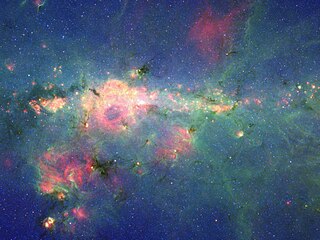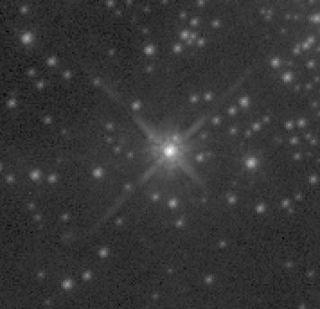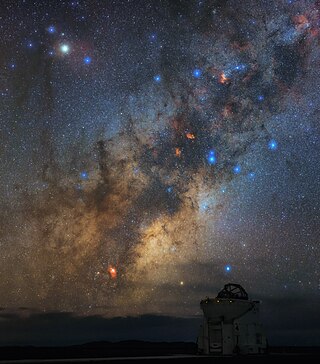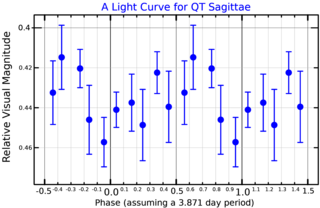
R136b is a blue supergiant star in the R136 cluster in the Large Magellanic Cloud. It is one of the most massive and most luminous stars known. It is found in the dense R136 open cluster at the centre of NGC 2070 in the Tarantula Nebula.

WR 102ka, also known as the Peony star, is a slash star that is one of several candidates for the most luminous-known star in the Milky Way.

WR 102ea is a Wolf–Rayet star in the Sagittarius constellation. It is the third most luminous star in the Quintuplet cluster after WR 102hb. With a luminosity of 2,500,000 times solar, it is also one of the most luminous stars known. Despite the high luminosity it can only be observed at infra-red wavelengths due to the dimming effect of intervening dust on visual light.

NGC 371, also called Hodge 53, is an open cluster 200,000 light-years away located in the Small Magellanic Cloud in Tucana constellation.

Melnick 42 is a massive blue supergiant star in the Tarantula Nebula in the Large Magellanic Cloud located in the constellation Dorado. Although it is only 21 times the size of the sun, its high temperature of 47,300 K makes it one of the most luminous stars of the Tarantula Nebula at 3,600,000 L☉. It is less than two parsecs from the centre of the R136 cluster, although that is well outside the central core.
HD 38282 is a massive spectroscopic binary star in the Tarantula Nebula, consisting of two hydrogen-rich Wolf-Rayet stars.
WR 142 is a Wolf-Rayet star in the constellation Cygnus, an extremely rare star on the WO oxygen sequence. It is a luminous and very hot star, highly evolved and close to exploding as a supernova. It is suspected to be a binary star with a companion orbiting about 1 AU away.

Melnick 34, also called BAT99-116, is a binary Wolf–Rayet star near R136 in the 30 Doradus complex in the Large Magellanic Cloud. Both components are amongst the most massive and most luminous stars known, and the system is the most massive known binary system.
BAT99-98 is a Wolf-Rayet star in the Large Magellanic Cloud. It is located near the R136 cluster in the 30 Doradus nebula. At 226 M☉ and 5,000,000 L☉ it is currently one of the most massive and luminous stars known.

WR 102 is a Wolf–Rayet star in the constellation Sagittarius, an extremely rare star on the WO oxygen sequence. It is a luminous and very hot star, highly evolved and close to exploding as a supernova.
WR 114 is a Wolf-Rayet star in the constellation of Scutum. It is an early type star of the carbon sequence (WCE) classified as WC5.

WR 93b is a Wolf-Rayet star in the constellation Scorpius, an extremely rare star on the WO oxygen sequence. It appears near NGC 6357 in the tail of the scorpion.
WR 2 is a Wolf-Rayet star located around 8,000 light years away from Earth in the constellation of Cassiopeia, in the stellar association Cassiopeia OB1. It is smaller than the Sun, but due to a temperature over 140,000 K it is 282,000 times as luminous as the Sun. With a radius of 89% that of the Sun, it is the smallest known WN star in the Milky Way.

WR 128 is a Wolf–Rayet star located about 9,500 light years away in the constellation of Sagitta. A member of the WN class, WR 128's spectrum resembles that of a WN4 star, but hydrogen is clearly present in the star, making it the only known hydrogen-rich WN4 star in the galaxy. However, similar H-rich very early WN stars can be found in the LMC and especially in the SMC, but the only other galactic examples of this are WR 3 and WR 152.
WR 69 is a Wolf–Rayet star located 11,350 light years away in the constellation of Triangulum Australe. It is classified as a WC9 star, belonging to the late-type carbon sequence. WR 69 is also a prolific dust maker, hence the "d" in its spectral type.
WR 150 is a Wolf-Rayet star in the constellation of Cygnus. It is one of the early-type carbon sequence (WCE), and is of spectral type WC5. WR 150 is very far from the Earth, being 28,500 light-years from it.

WR 120 is a binary containing two Wolf-Rayet stars in the constellation of Scutum, around 10,000 light years away. The primary is a hydrogen-free weak-lined WN7 star, the secondary is a hydrogen-free WN3 or 4 star, and the system is a possible member of the cluster Dolidze 33. From our point of view, WR 120 is reddened by 4.82 magnitudes, and it has the variable designation of V462 Scuti.
BAT99-7 is a WN-type Wolf-Rayet star located in the Large Magellanic Cloud, in the constellation of Dorado, about 160,000 light years away. The star has a spectrum containing extremely broad emission lines, and is the prototype for the "round line" stars, Wolf-Rayet stars whose spectra are characterized by strong and broad emission lines with round line profiles. The broad emission lines hint at an extremely high temperature of nearly 160,000 Kelvin, which would make it the hottest of all WN stars with known temperatures, as well as an extraordinarily large mass loss rate for a Wolf-Rayet star in the LMC, at 10−4.48 M☉/yr, which means that every 30,200 years, the star loses 1 solar mass worth of mass.
WR 119 is a Wolf–Rayet star located about 10,500 light years away in the constellation Scutum. WR 119 is classified as a WC9 star, belonging to the late-type carbon sequence of Wolf-Rayet stars. WR 119 is noteworthy for being the least luminous known Wolf-Rayet star, at just over 50,000 L☉. The most recent estimate is even lower, at just 42,700 L☉, based on the most recent analysis using Gaia DR2 data.









